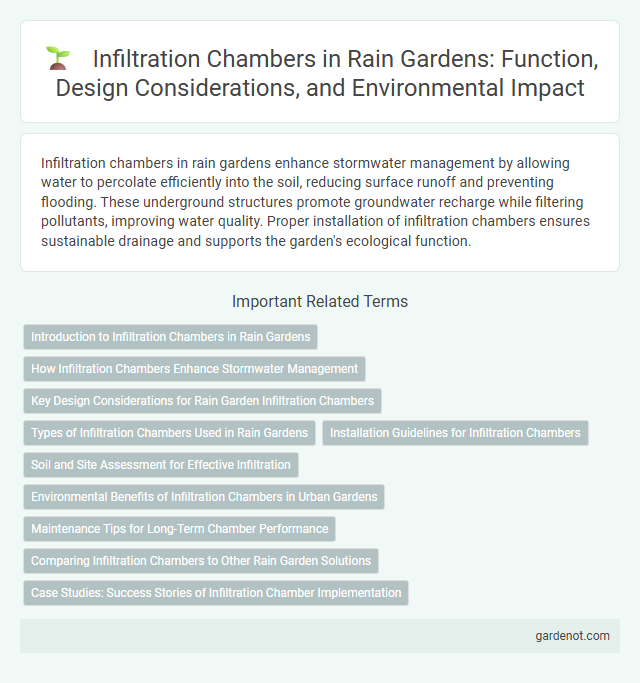Infiltration chambers in rain gardens enhance stormwater management by allowing water to percolate efficiently into the soil, reducing surface runoff and preventing flooding. These underground structures promote groundwater recharge while filtering pollutants, improving water quality. Proper installation of infiltration chambers ensures sustainable drainage and supports the garden's ecological function.
Introduction to Infiltration Chambers in Rain Gardens
Infiltration chambers in rain gardens are underground structures designed to capture and slowly release stormwater, promoting groundwater recharge and reducing surface runoff. These chambers are typically made from durable materials such as plastic or concrete, arranged to create void spaces that temporarily hold water before infiltration. By enhancing soil permeability and water retention, infiltration chambers improve the efficiency of rain gardens in managing urban stormwater sustainably.
How Infiltration Chambers Enhance Stormwater Management
Infiltration chambers significantly improve stormwater management by efficiently capturing and storing runoff, allowing gradual percolation into the surrounding soil. These underground structures prevent surface flooding and reduce the burden on municipal drainage systems by promoting natural groundwater recharge. Their high storage capacity and permeability make them ideal components for sustainable rain garden designs, enhancing urban water resilience.
Key Design Considerations for Rain Garden Infiltration Chambers
Key design considerations for rain garden infiltration chambers include selecting materials with high permeability to enhance stormwater absorption and prevent surface runoff. Proper sizing based on soil infiltration rates and expected runoff volume ensures effective water detention and groundwater recharge. Structural stability and maintenance access are crucial to avoid clogging and maintain long-term chamber performance.
Types of Infiltration Chambers Used in Rain Gardens
Infiltration chambers used in rain gardens include modular plastic chambers, concrete vaults, and corrugated metal systems, each designed to promote efficient stormwater infiltration and storage. Modular plastic chambers are lightweight and easy to install, providing high void space for water retention, while concrete vaults offer durability and greater load-bearing capacity. Corrugated metal chambers are favored for their cost-effectiveness and resistance to corrosion, making them suitable for varied soil conditions in rain garden applications.
Installation Guidelines for Infiltration Chambers
Infiltration chamber installation requires careful site assessment, ensuring soil permeability meets design specifications with permeability rates typically between 0.5 to 3 inches per hour. Chambers must be placed on a stable, well-compacted bed, maintaining a minimum 12-inch vertical separation from the highest seasonal water table to optimize stormwater infiltration. Proper backfilling using clean, washed aggregate prevents sediment clogging, while ensuring inspection ports remain accessible for future maintenance.
Soil and Site Assessment for Effective Infiltration
Infiltration chambers require thorough soil and site assessment to ensure effective water absorption and prevent system failure. Analyzing soil texture, permeability, and groundwater depth is critical for determining the infiltration capacity and suitability of installation locations. Proper evaluation of site slope, drainage patterns, and soil contamination enhances performance and longevity of rain garden infiltration chambers.
Environmental Benefits of Infiltration Chambers in Urban Gardens
Infiltration chambers in urban rain gardens significantly enhance groundwater recharge by capturing and slowly releasing stormwater, reducing surface runoff and mitigating urban flooding. These systems filter pollutants like heavy metals and sediments, improving water quality before infiltration. By promoting natural water cycles and supporting soil health, infiltration chambers contribute to urban ecosystem sustainability and resilience against climate impacts.
Maintenance Tips for Long-Term Chamber Performance
Regular inspection and cleaning of infiltration chambers prevent clogging and ensure optimal water flow. Removing sediment buildup and debris from chamber inlets and outlets maintains permeability and prevents overflow. Scheduling annual maintenance checks and using non-invasive vegetation around the chamber support long-term functionality and longevity.
Comparing Infiltration Chambers to Other Rain Garden Solutions
Infiltration chambers offer superior stormwater management by providing greater underground water storage and promoting efficient infiltration compared to traditional rain garden basins. Unlike shallow soil beds, these chambers prevent surface flooding and minimize soil compaction, enhancing groundwater recharge capacity. Their modular design allows for scalable implementation in urban environments, outperforming conventional bioretention systems in durability and maintenance efficiency.
Case Studies: Success Stories of Infiltration Chamber Implementation
Infiltration chambers have proven effective in multiple case studies, significantly reducing stormwater runoff and enhancing groundwater recharge in urban areas. Notable implementations include Seattle's Thornton Creek project, where infiltration chambers mitigated flooding and improved water quality by capturing and slowly releasing rainwater. Such success stories highlight the chambers' capacity to manage stormwater sustainably, supporting environmental goals in diverse climates and soil conditions.
Infiltration chamber Infographic

 gardenot.com
gardenot.com